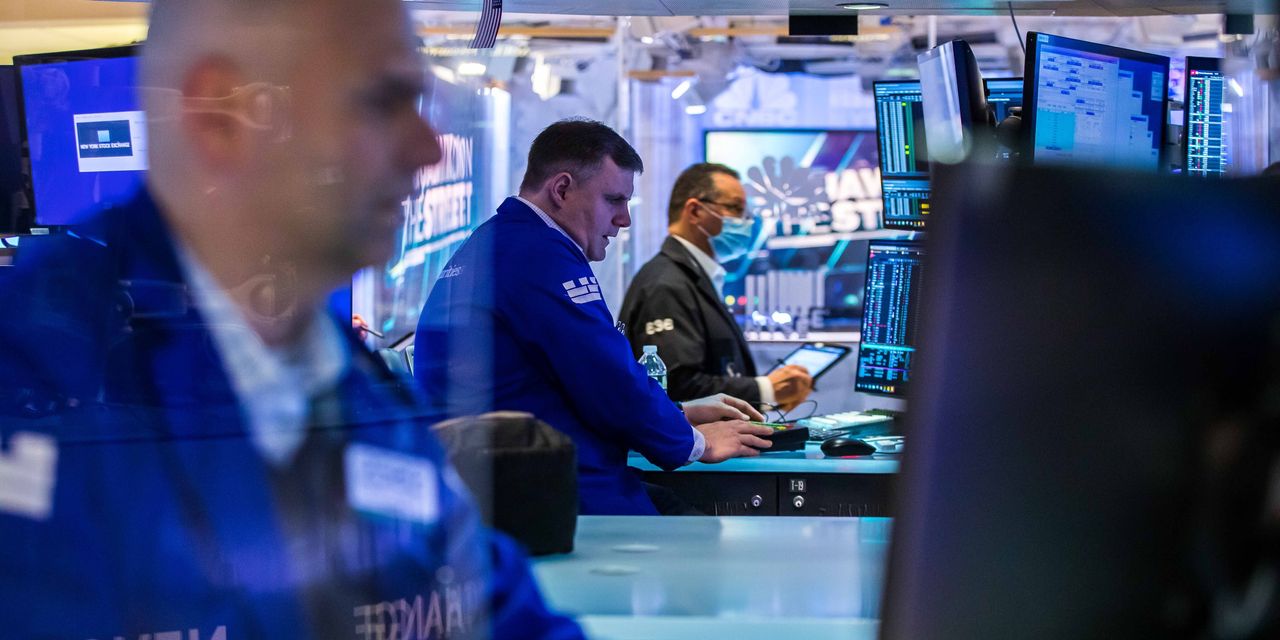US stocks swung between gains and losses on Tuesday as uncertainty over inflation, interest rates and the economy continued to weigh on the market.
All three major indexes opened higher, with the technology-heavy Nasdaq Composite up 2.8% at one point. By late morning, stocks had mostly erased those gains and appeared on track to extend a brutal three-day slide. But as the afternoon wore on, investors turned their attention to Wednesday’s report on consumer prices and the possibility that inflation may be peaking—and stocks rebounded again.
The S&P 500 closed up 9.81 points, 0.2%, at 4001.05, a day after the broad index slumped 3.2% to its lowest level for the year. The Nasdaq Composite Index climbed 114.42 points, or 1%, to 11737.67.
“The market was taking too negative of a read on the consumer-price index, leading to the afternoon recovery,” said Matt Peron, director of research at Janus Henderson Investors.
The Dow Jones Industrial Average fell for a fourth straight trading session, hitting a 52-week low. It closed down 84.96 points, or 0.3%, at 32160.74.
A cocktail of geopolitical risks and economic headwinds is posing the biggest threat to global growth in years and rattling markets. In the US, soaring inflation has prompted the Federal Reserve to begin raising interest rates and investors fear the move could tip the economy into recession.
Global markets are looking equally troubled. In China, resurgent Covid-19 outbreaks and Beijing’s strict approach to fighting them threaten to revive the supply chain bottlenecks that first drove inflation higher. In Europe, the war in Ukraine threatens to keep energy prices elevated and is weighing on the region’s growth.
“People came in this morning expecting a relief rally after being hammered the last few days,” said Joe Quinlan, head of CIO Market Strategy for Merrill and Bank of America Private Bank. “But with inflation in the US, the Covid challenges in China and the war in Ukraine, we rarely have seen three major market-moving catalysts converge.”
Early Tuesday, some investors snapped up shares that had been battered by those headwinds.
“Everyone at this point is looking to see if we’ve bottomed,” said Quincy Krosby, Chief Equity Strategist for LPL Financial. “The instincts are that we haven’t bottomed yet.”
Wednesday’s report on fresh consumer-price index data is expected to show inflation rose at a slower pace in April than the previous month, Ms. Krosby said.
Investor sentiment can turn on a tell me, she added. In January 2019, a speech by Fed Chairman Jerome Powell signaled the central bank would be patient with rate increases—reversing a steep market selloff.
The market has entered a new era, Mr. Quinlan said, and investors are more inclined to wait for solid evidence that those challenges have subsided before betting the stocks have reached a bottom.
“Investors are very skeptical now,” he said. “They want to see the data. They don’t want to listen to policy makers. Any improvements build the scaffolding for the bottom. But we’re not there yet.”
Federal Reserve Bank of New York President John Williams said Tuesday that he believes the Fed can achieve a “softish landing” for the US economy while raising rates, though the unemployment rate could rise.
“By 2023 you are very likely to see growth slowing very significantly, and the specter of recessions is really starting to loom,” said Seema Shah, chief strategist at Principal Global Investors.
“What we are seeing is the realization that it is going to be very tough for the Fed to get that soft landing just right.”
Investors on Tuesday were welcoming signs that the conflict in Ukraine wasn’t escalating and a planned EU embargo on Russian oil could face delays, Ms. Shah said.
Peloton Interactive fell $1.23, or 8.7%, to $12.90 after reporting declining sales and mounting losses as the stationary-bike maker struggles with the return to prepandemic consumer habits.
Biohaven Pharmaceutical Holding Co..
raised by $56.86, or 68%, to $140 after Pfizer said it would buy the rest of the company for around $11.6 billion.
Duke Realty rose $1.87, or 3.9%, to $49.58 after Prologis said it had made an offer to buy the real-estate investment trust for about $23.7 billion. Prologis fell $6.96, or 5.3%, to $125.41.
The yield on the benchmark 10-year Treasury note edged down to 2,990% from 3,080% on Monday.
Brent crude oil fell $3.48, or 3.3%, to $102.46 a barrel. Oil prices had been rising for the past few months, but concerns that China’s lockdowns will sap demand for commodities have taken some steam off the rally.
Demand for oil in China is likely to rebound sharply when restrictions start to ease, though the European Union’s proposed ban on imports of Russian oil remains an overhang, said Daniel Hynes, a senior commodity strategist at ANZ in Sydney.
“The fundamentals are still very tilted toward an extremely tight market with certainly risks skewed to further declines in supply over the next three to six months,” Mr. Hynes said.
Bitcoin prices edged lower after a steep selloff. The world’s largest cryptocurrency on Tuesday traded at $30,959.99 as of 5 pm ET, down 0.4% from $31,075.70 at the same time a day earlier.

Asian equity benchmarks were mixed Tuesday.
Photos:
Kin Cheung/Associated Press
Overseas, the pan-continental Stoxx Europe 600 rose 0.7%. In Asia, Japan’s Nikkei 225 closed 0.6% lower, the Shanghai Composite rose 1.1% and Hong Kong’s Hang Seng Index dropped 1.8%.
Write to Justin Baer at [email protected], Will Horner at [email protected] and Dave Sebastian at [email protected]
Corrections & Amplifications
The S&P 500 was previously up 0.7%. An earlier version of this article incorrectly said the index was up 07%. Additionally, the S&P 500 closed up 0.2%. An earlier version of this article incorrectly said it finished 0.2% lower. (Corrected on May 10.)
Copyright ©2022 Dow Jones & Company, Inc. All Rights Reserved. 87990cbe856818d5eddac44c7b1cdeb8
.
